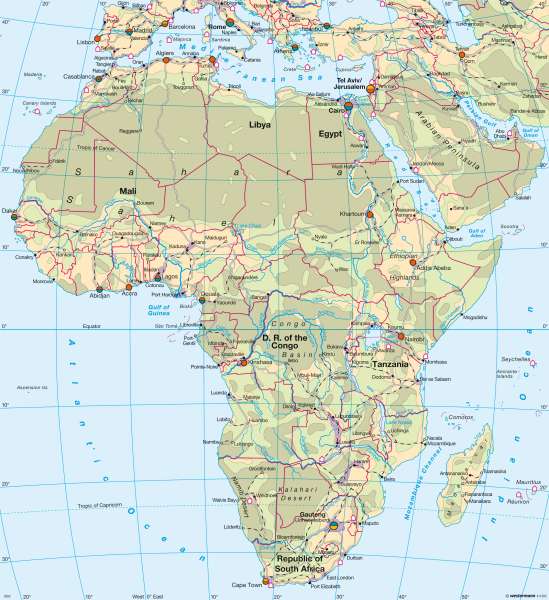Economy (overview)
Africa - Economy
978-3-14-100790-9 | Page 160 | Ill. 1

Information
In Africa, densely populated regions with higher mining, industrial and service sectors only appear to be insular. These regions are largely connected to the remains of the mining industry, historical power centres and colonial capitals. Large parts of the Africa population live off the informal sector, but this isn't shown on the map. For the vast majority of poor, it is a "survival economy", whereas for the political-military-economic "elite" and other rich minorities, there is a source of enormous wealth, much of which is gained through illegal activities such as diamond, arms trafficking and money laundering.Major global economic centres do not exist in Africa as large regions of the continent have hardly been affected by globalisation. Major continental economic centres are Cairo, Johannesburg / Pretoria. Most urban centres in Africa are political and cultural centres with regional or national importance.
Rural and cultural landscapes
The arable agricultural regions reflect population density. These are core regions of historic, colonial African states with developed coastal and lowland areas of high immigration. Generally, market-oriented smallholder agriculture dominates. There are also plantation economies in the coastal regions and interior highlands to the East and South of Africa. Next to vast natural landscapes, areas of less economic use are found. A semi-nomadic culture dominates in the arid regions of North, West and East Africa (the dry belt of the "Old World"), along with a dynamic oasis economy (including electricity oases along the Nile and Senegal), large irrigation areas of the Niger, Mali and Gesira in Sudan and modern farming, ranch economy and irrigated crops in Southern Africa. In the rain forests of Central Africa, there are remnants of hunter-gatherer cultures, which are now threatened by the timber industry. Some semi-natural landscapes areas are internationally important tourist regions, such as the Kruger National Park in South Africa and the Serengeti National Park in East Africa. Other internationally important tourist sites and world heritage sites (Nile Valley) are located on North African coasts.
Among the mining regions
Africa is still a "mining continent" and the following areas of importance for the world market can be distinguished here:
— The rapidly expanding energy regions in North, West and Central Africa with oil and natural gas (some with offshore funding) as well as South Africa with coal and uranium.
— The precious metal regions in South Africa with gold and platinum and in West Africa (gold).
— The "diamond regions" in South, Central and West Africa (in the map "minerals" are under the signature "M").
— "Metal regions" of South and Central Africa.
Mining resources were a major reason for the colonial development of Africa in the 19th Century, which continues to the present day with exploitation by transnational corporations. At the same time, mining products are the most important export value in many African countries.
As a consequence of the mining industry, urban agglomerations have developed in southern and central Africa with traffic routes focused on the mining centres. The mining industry provides employment (worker migration) and prosperity, mostly for overseas owners of these sites, and leaves behind severe environmental damage and social problems. Political, scientific and peace initiatives have now appropriately given the term "blood diamonds". This explains the wars in Central and West Africa over the struggle for these "raw materials" and there would not be the illegal sale of raw materials without the revenue from the allocation of mineral rights.
Industrial Centres
The distribution of industrial sites shows two types of locations: many coastal locations and a few locations in the interior. The coastal towns are linked to colonial business enterprises for export and the internal market, as internal sites in East and South Africa supply the population and purchasing power of the agglomerations and mining companies in the interior.
At a relatively large number of locations, there are light industries of textile, garment and leather, the typical "Third World" products manufactured for export and the internal market.
Food and beverage production (flour, fats, drinks and cigarettes) and industrial fish processing is done mainly for export. Fish consumption in West Africa is covered by lakes, rivers and by imports (dried cod from Norway).
The heavy oil refineries supply the domestic market or the region of North Africa and are oriented for export to Europe. The chemical and plastics are aimed for export as well as the large-scale, single-market of the fertiliser industry. Mostly, medium and small enterprises for the manufacture of paints and coatings, pharmaceutical products and plastic pipes are to be found.
Among the metal processing companies, most are not of a European dimension, but rather, small to medium sized businesses that work for the local and regional markets, in particular, in metal work.
It is striking that the major high-tech industries only occur in South Africa.
Distribution, numerous "countries without industry" and the industrial sector breakdown show that Africa has a very low industrialisation, not only in a global comparison, but also in comparison with "development" regions such as South America and Asia. The needs of a population with very low purchasing power are met mainly by products from the informal sector such as crafts or smuggled and imported goods. Tourism is regarded in many countries as the most important "growth industry".
B. Wiese; Ü: C. Fleming




